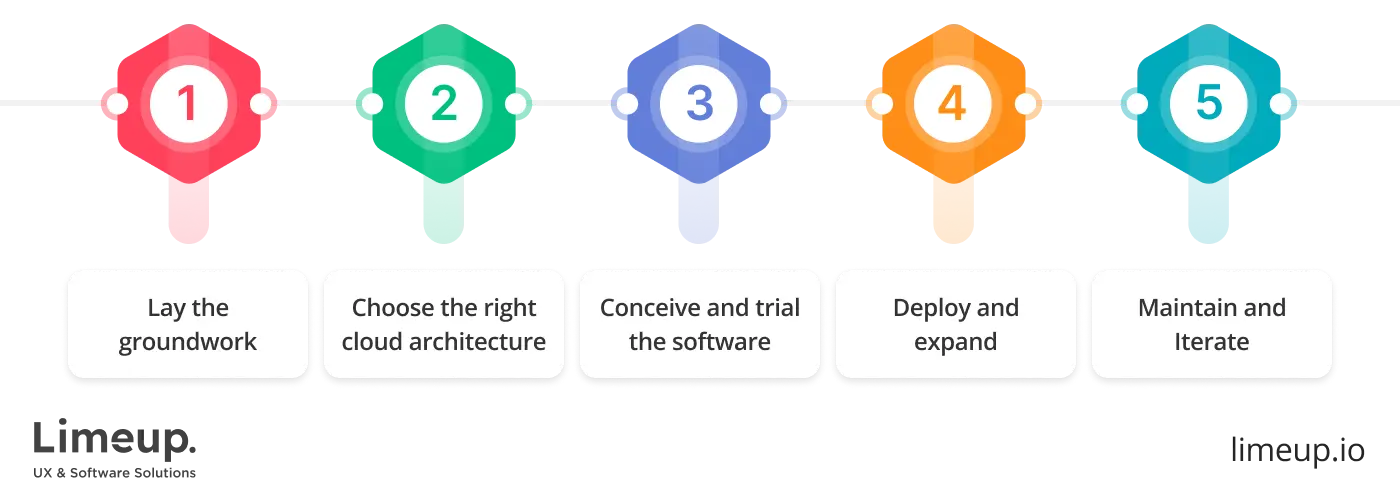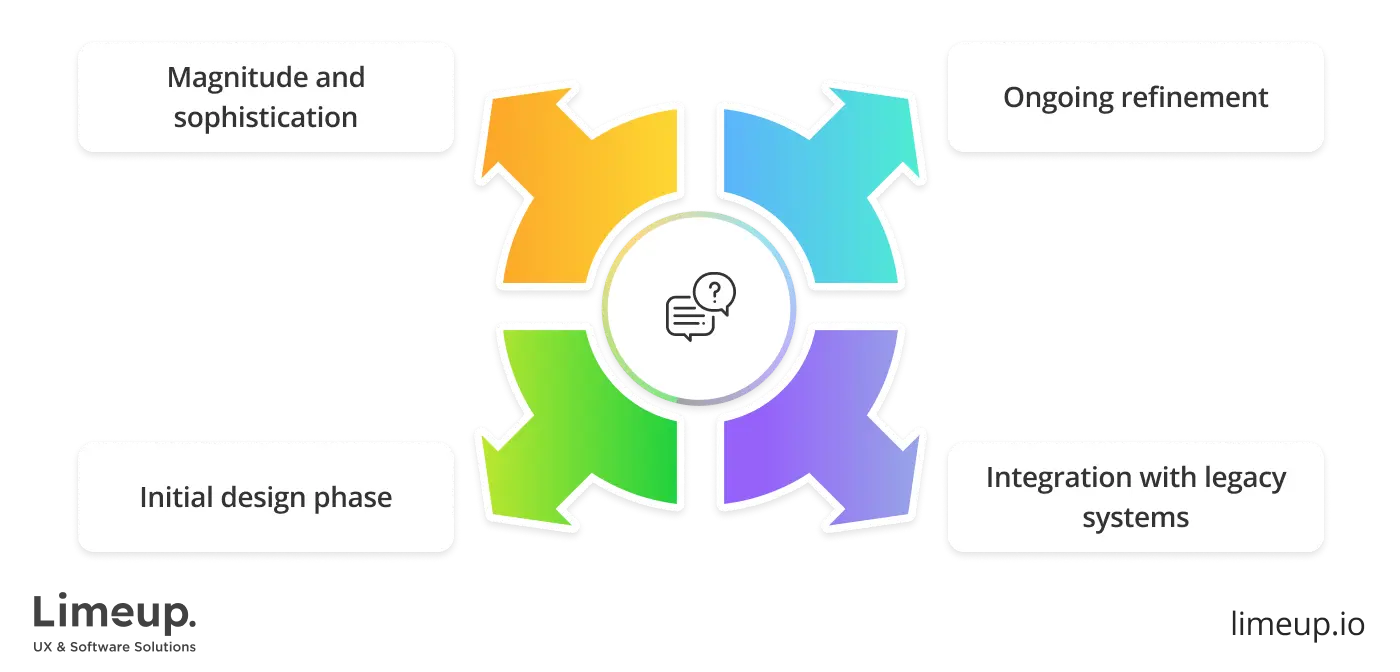How to Build a Cloud Software: Brief Overview

Cloud software development is like unlocking a new dimension for your venture. It sets you on a path to outstrip the limitations of old-school systems, welcoming a landscape of unbounded versatility and progress. In this blog post, we will steer you through the outline of web-based software creation and give you a sneak peek into the steps it takes to realize a cloud-centered ambition.
If you’re wondering how to build cloud software, the answer lies in the artistry of cloud-savvy engineers with the Midas touch who turn your ideas into gold. These developers are the architects behind the scenes, breathing life into your ideas and ensuring the infrastructure is solid, reliable and ready for anything the digital world throws its way.
Cloud-based software development is more than just a trend — it’s the future of how we create, share and scale solutions. With appropriate virtual system design services, businesses may tap into an ecosystem that’s dynamic, agile and capable of evolving at the speed of light. When you are geared up to step on the gas with your endeavor, check out Limeup’s DevOps running on all cylinders in cloud operations.
What is cloud software?
In today’s digital world, web-hosted apps have become the unsung hero, quietly revolutionizing how we work, collaborate, create. Imagine having all your data, applications and services accessible from anywhere, anytime, without the need for bulky hardware or complex setups.
That’s the magic of remote-access software — an ecosystem that lives on the internet, offering users the freedom to access tools and information with just a few clicks. It’s like having your own personal digital toolbox, ready to go wherever you do.
The most outstanding feature of internet-powered applications comes from their instant capacity to expand when needed. An era of unrestricted commercial activity emerged through physical freedom and storage capacity elimination.

So what is cloud software development? A revolutionary approach grants companies ability to nimbly adjust their resources, responding fluidly to the unpredictable nature of demand, just as a well-fitted ensemble conforms perfectly to its owner’s physique.
The beauty of the cloud? It grows with you. As your firm grapples with rising data volumes or growing processing demands, loud solutions effortlessly take the reins, preserving that operations continue unhindered by any obstacles in sight.
Every organization is drawn toward the outstanding capabilities of virtual software platforms. The cloud is no longer just a luxury for forward-thinking companies as leveraging this platform becomes required for staying ahead. You will need to hire software developers to establish a noteworthy mark in the market. Your business will harness the full potential of web-based apps, with their mastery driving consistent excellence across all digital touchpoints.
Ready to embrace the future? The cloud is calling.
Why choose cloud software development?
Web-hosted applications transcend being a mere convenience; it’s a transformative force in how organizations outmaneuver the competition in cut-throat space of modern commerce. It’s like upgrading from a tricycle to a high-performance sports car: faster, smarter, with a whole new world of opportunities at your fingertips. With the cloud, you are free to scale, transform, innovate, unburdened by the limits of traditional systems.
The beauty of virtual product engineering lies in its capacity to shift gears effortlessly. Stepping away from outdated systems that drain resources with constant maintenance, such solutions flex and grow in sync with your operation.

Need more storage or extra computing power? A click gets the job done — no costly hardware required. You pay for what serves your goals and as your enterprise advances, it shifts accordingly. A cloud software developer is able to engineer a fluid framework that synchronizes with shifting landscape of your sphere, keeping your infrastructure at the pinnacle of technological progress.
The study shows enterprises embrace web-based services by utilizing at least one cloud service among 94% of organizations indicating its growing acceptance. This widespread adoption speaks volumes about the impact this technology has had on the way companies function. As firms strive to stay agile and competitive, embracing distributed computing is non-negotiable.
Opting for cloud software engineering boosts your capabilities and opens the door to endless possibilities. A dedicated development team brings together the best minds to focus on your project, piecing together blueprints that go beyond expectations. Their deep understanding of these technologies enables them to create software tailored to your unique demands. From improving operational efficiency to scaling your product range, this crew has the skills to drive your product forward.
Private cloud software development also offers significant cost savings. With no need for expensive on-site infrastructure or long-term commitments to hardware, companies may reduce capital expenditures and shift to a more predictable operational cost structure. It’s the kind of pliability that allows startups and established enterprises alike to invest in innovation without breaking the bank.
As the old saying goes, “Don’t put all your eggs in one basket.” With the hosted environment, you may spread your risk, diversify your operations, ensure that your data is protected and accessible from anywhere. Rolling out a fresh idea to market, expanding your reach, or refining internal systems requires a foundation built for growth. Harnessing cloud-native technology infuses your business with resilience, operational fluidity, strategic edge to excel.
What are the main steps in creating cloud software?
Rushing in without a plan is like setting sail without a map — sooner or later, you will find yourself lost in a sea of complexities. That’s why software development companies in London and globally are essential to steer the project in the right direction, making sure every phase is executed with precision.

1. Set the stage and draw the blueprint
Every great innovation starts with a clear purpose. Before a single line of code is written, the team must outline the core functionalities, target audience, long-term goals. A well-structured roadmap keeps the initiative from drifting off course, preventing costly detours. Research reveals that 70% of digital transformation efforts falter due to unclear goals — solid groundwork is therefore indispensable.
2. Choose the right cloud architecture
Developing cloud software requires a bespoke strategy, as no single formula fits every scenario. Firms must weigh their options among public, private, or hybrid web-hosted architectures that best uphold their security fortifications, upgradability ambitions, fiscal prudence. Settling on the wrong infrastructure invites roadblocks at every turn, transforming performance into a constant uphill battle instead of a smooth ride.
3. Conceive and trial the software
With the framework set, the real engineering begins. Coders weave complex logic, integrate APIs and fortify security layers, forging a system designed to stand the test of time. Every function undergoes a deep dive to catch even the smallest flaws before they spiral into major disruptions. Rigorous testing, from unit assessments to load evaluations, strengthens the backbone of the software, preparing it to tackle real-world demands without a hitch.
4. Deploy and expand
Releasing cloud software marks the start of a continuous evolution. A carefully orchestrated launch plan at the bay guarantees a trouble-free shift from testing to full-scale operation, safeguarding against downtime.
Cloud-native systems alter instantly to shifting demands, handling surges in activity without missing a beat. Automated monitoring keeps a watchful eye, catching and resolving issues before they gain momentum, keeping performance sharp and reliability unwavering.
5. Maintain and Iterate
The journey doesn’t end at deployment. In fact, it’s only just begun. Cloud software by nature is dynamic and over time, its environment and users’ needs will evolve. Regular updates, bug fixes and uplifts based on user feedback are essential for keeping the software relevant and effective.
The secret to ongoing success is to hire a cloud software development team. With their know-how, your future-ready constructs will naturally evolve, improving on every front and staying perfectly in sync with shifting priorities.
This phase is directed at continuous improvement and adding new features. Virtual frontier gives market players the edge to stay agile, adjusting to shifts and anticipating future demands. Introducing new features or streamlining performance keeps the software in peak form, performing like clockwork and racing ahead of competitors.
How long does cloud-based software development take?
When embarking on the journey of web-based software engineering, it’s natural to wonder, “How long will this take?” The honest answer is — it depends. Cloud product creation requires a balance of thoughtful planning, intricate design and rigorous testing. While the previous steps in building cloud software set the stage, the time it takes to bring it all together is influenced by many moving parts.

First off, it is vital to grasp that no two endeavors are the same. The magnitude and sophistication of your software, combined with the number of features and chosen technologies, influence how long it will take to bring it to fruition. More substantial undertakings, like custom enterprise solutions, will naturally take more time to construct and fine-tune than smaller, less complex applications. It’s a marathon, not a sprint.
The initial design phase sets the tone, but it’s important to realize that the process doesn’t always follow a straight path. While your staff starts out with a clear destination, the journey may take unexpected turns as setbacks arise, new features are introduced, or the technology evolves. This is especially true for cloud-based frameworks, where conforming to new technologies and business needs is a continuous cycle.
One of the biggest time-saving advantages of cloud software development is the ability to iterate quickly. The cloud ecosystem enables engineers to implement and refine minor adjustments regularly, facilitating the detection and resolution of issues before they snowball. This cycle of ongoing refinement often outpaces conventional software creation progression, fostering constant evolution and enhancement.
But what about unexpected bumps in the road? Cloud-based software comes with its own set of snags, such as integrating with legacy systems, safeguarding data, or meeting regulatory standards. These stumbling blocks may slow things down and though they can’t always be foreseen, a savvy team knows how to maneuver through them with ease to create cloud software.
Keep in mind, it’s not about sidestepping every hurdle, but about how you rise to the occasion that truly counts.
While we touched on timelines in the previous chapter, it’s worth mentioning that a good rule of thumb is that venturing into the cloud frontier may take anywhere from a few months to over a year, depending on the scope. That’s a broad range, but it serves as a reminder that patience is key. As the saying goes, “Good things come to those who wait.” Quality cloud software takes time, but with a dedicated squad driving the venture, the end result will be well worth it.
Should you wish to set sail on this adventure and need a hand on the tiller to guide you, don’t wait — take the plunge and bring your vision to life in the cloud.
How much do cloud software development services cost?
The monetary commitment for cloud-centric software applications is subject to variation, molded by a spectrum of indispensable elements that define its scope. One of the primary elements to consider is the complexity of the project. Piecing together a no-frills application with fundamental capabilities will inevitably require fewer resources unlike curating a next-level digital suite designed for boundless expandability.
The more intricate the software, the higher the associated costs. To build cloud software that is feature-rich, the engineering staff must bring their A-game, using additional time and superior resources.

Key factors that influence software development costs include:
- Functionality. The number and complexity of features and integrations required can make or break the budget. When advanced functionalities like real-time data processing, intricate algorithms, third-party integrations are in the mix, the price tag inevitably climbs.
- Scalability. Designing software to accommodate large user bases or evolving operations over time demands more resources upfront. Assembling elasticity into your endeavor from the get-go ensures that your system may grow alongside your business.
- Security. In cut-throat digital landscape, protecting data is not just an option; it’s a necessity. Tailored security features like encryption, two-factor authentication, compliance with stringent regulations pile on additional costs.
- Custom design. When aiming for a product that stands out, cookie-cutter designs simply won’t cut it. Crafting interaction flows and visual elements to fulfill distinct criteria usually results in a marked rise in cost.
The geographical context greatly affects the financial landscape of your initiative. Companies based in high-cost areas such as London, San Francisco or New York will likely see a premium price for their services. Conversely, outsourcing to regions like Eastern Europe, India or Southeast Asia may propose more budget-friendly options, though there might be obstacles related to communication and cultural alignment.
The competence of the team plays a central role in the outcome of the venture. Hiring first-rate cloud software developers with wealth of knowledge in web-based systems often comes with a higher price tag. But what you are paying for is know-how that may tip the scales in the quality and longevity of the software. Skilled professionals are able to hammer out an adaptable, secure system that will perform seamlessly for years.
As far as timelines go, haste comes at a price. Accelerated schedules often require more resources, late hours and close project supervision, all of which inflate the overall cost. A longer timeline might keep the budget in check, but the true goal is to balance speed with world-class quality.
The breakdown of additional influencing factors:
- Infrastructure & hosting. The choice between cloud-based or on-premise hosting affects long-term expenses. Online models often require ongoing subscription fees, while local setups involve higher upfront costs for hardware and maintenance.
- Regulatory compliance & audits. Industries like finance, healthcare, insurance must meet stringent regulatory standards. Conformity with GDPR, HIPAA, or PCI DSS may demand a bit of extra development, legal consultations and third-party audits.
- Localization & multi-tenancy. If software serves global markets, adapting it for software localization, multiple languages, currencies, region-specific compliance may add complexity. Multi-user environment architectures for SaaS products further impact costs due to auxiliary resource allocation.
- AI & automation enhancements. Implementing artificial intelligence, machine learning, or process automation may improve efficiency but also demands industry-specific know-how and extended project duration.
Gaining insights from trained pros may help match your expectations with the true costs, making sure you extract maximum value from your investment. As the old saying goes, there’s no such thing as a free lunch — and when it comes to cloud software, that couldn’t be more accurate.
Final thoughts
In summary, cloud strategies invigorate trajectories, unleashing novel frontiers for expansion and creative milestones. By embracing cloud-based apps, organizations acquire the freedom to recalibrate their course, push into unknown realms and stretch beyond the possible. Cloud infrastructure underpins the modern enterprise, improving operational workflows, enabling flexible scaling, ensuring immediate access to essential data.
The path, though detailed, is purposefully structured to forge resilient, pliable platforms that keep pace with the fluctuating rhythms of your enterprise without lifting a finger. A deep understanding of its key stages enables companies to streamline deployment, trim costs, bolster security. Cloud software is far from a fleeting fad as it represents the future of enterprise, ushering in a realm of potential for those daring enough to embrace it.
Poised to explore the revolutionary cloud software development services? Limeup stands ready to walk beside you through every step. Rely on our adept artisans, connect with us to weave one-of-a-kind products that mirror your ambitions. Take action today and launch an exciting voyage toward unmatched innovation with Limeup!

